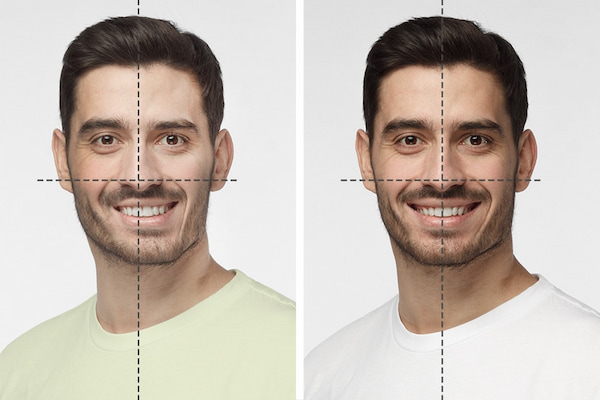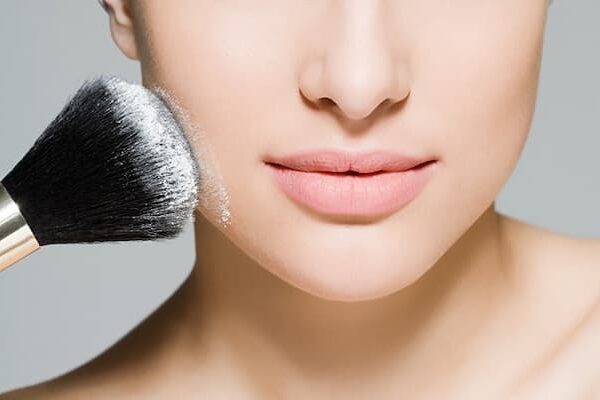To start with, how to fix facial asymmetry?
Fixing an asymmetrical face might sound impossible without undergoing invasive cosmetic surgery treatments, but guess what? It’s simpler than you might think, in actuality!
With the help of various non-surgical, minimally invasive treatments, it is now possible to restore facial proportions and rejuvenate features, thanks to the most recent developments in facial aesthetic procedures.
Asymmetry on the face, such as one cheek being fuller than the other or one eyebrow being higher, may bother you. Or perhaps you’ve noticed that your skin is becoming less elastic and your face is beginning to lose volume. Then you should read this post.
We will explain all your options when it comes to the most popular cosmetic procedures to fix an asymmetrical face.
Please read on for more information about how to fix facial asymmetry.
Table of Contents
How Do I Know If I Have Facial Asymmetry?
Simply put, the terms “facial symmetry” and “facial asymmetry” refer to the mirroring of features on your face in terms of size, shape, and color. Natural asymmetries are present in almost everyone, though many of them go completely unnoticed by the untrained eye.
“You may have noticed a recent social media craze where photographs of well-known individuals who are widely regarded as being very attractive are photo-shopped to make their features perfectly symmetrical, says RN Danae, one of the enthusiastic and knowledgeable Cosmetic Registered Nurses at Youth Lab. “The end result is strange and slightly unsettling. This illustrates how typical, and even attractive, mild facial asymmetry is.”
One of the reasons clinical imaging is such a crucial component of our process at Youth Lab is that facial asymmetry is frequently more obvious in photographs than in real life. This is also the reason why the complaint “I don’t like how my nose, eyes, or lips look in photos” is frequently heard.”
Examples that our practitioners frequently observe include uneven pigmentation, a loss of volume or a less defined jawline on one side of the face, an uneven lip shape, and a difference in eyebrow or eyelid height. Most of the time, nobody notices these problems besides the client! This can understandably affect the client’s confidence and perception of their physical attractiveness when others start to notice or when the problem intensifies.
At home, it’s simple to spot asymmetry in your face shape. Chances are you’ll be the first to notice it if you have obvious asymmetry. However, a trained cosmetic nurse or doctor’s eye can spot asymmetries you’re unaware of. Occasionally, you might not understand why you feel uneasy or that a particular feature on your face doesn’t quite “look right.” Particularly true for features like noses, which are challenging to evaluate from every angle, is this.
It’s crucial to not take any online symmetry or “attractivity” calculators seriously. As you are aware, beauty and attractiveness are incredibly subjective. There is also no substitute for the trained human eye when it comes to determining facial symmetry.
Taking a front-on headshot of your face with a partner to help you avoid any unlevel angles is one way to check your own facial symmetry at home. Then you can make important facial markings like the peak of the forehead, the chin’s edge, the inner and outer corners of both eyes, the corners of the lips, the widest part of the nose’s bridge, and the widest part of the face. This will enable you to identify any points that are either higher or lower than their corresponding counterparts.

What Options Do I Have To Fix An Asymmetrical Face
Surgery and non-surgery are typically the two types of solutions available for this kind of problem.
Surgery:
- It is a Permanent solution
- The implants can be made out of Silicone, Metal & Plastic
- The recovery time can be 6 weeks depending on the individual
Non-Surgical:
- It is a semi-permanent solution (lasts up to 2 years)
- It is through the use of anti-ageing injections & Fillers
- The maximum recovery time you can have is 48 hours
Why Does My Face Have Asymmetries?
There are numerous causes of facial asymmetry, some more serious than others. While some causes emerge and become more severe with aging, others are lifelong. It’s critical to distinguish between mild, unproblematic asymmetry that only affects appearance and more pronounced asymmetry that could be a sign of a more serious medical condition.
- Lifestyle. Sleeping position is a factor that we frequently observe affecting facial symmetry. On one side of the face, sleeping on your side all night long can have a flattening effect. Due to the uneven depletion of collagen and elastin caused by this pressure, the side you sleep on may develop more fine lines and wrinkles and a volume deficit. For the smokers out there, if you regularly smoke on one side of your mouth, the repetitive puckering of your lips can result in extra fine lines around the mouth that are more obvious on that side than the other.
- Ageing. Unfortunately, aging greatly affects facial symmetry, despite the fact that we occasionally wish we could turn back the hands of time. This includes more prominent wrinkles, sagging facial features, and other skin structure changes that may get worse on one side of the face more quickly than the other.
- Genetics. Even when they aren’t wanted, asymmetry-causing traits like crooked smiles and noses can become family heirlooms. This type of asymmetries are genetic, typically unavoidable, but not always untreatable.
- Dental Procedures. The jawline and mid-to-lower face are frequently made asymmetrical by tooth extraction. The pressure on the corresponding area of the jaw may be relieved when a tooth is extracted from below the gum line. This causes uneven bone reabsorption over time, which causes asymmetry in the face. In addition to the lips appearing uneven and shrunken, tooth loss can also affect them. Veneers or dentures may be able to partially help with this.
- Health issues:
- Injuries. Even after healing, a childhood or adult facial injury, particularly one to the nose or mouth, can leave the face looking asymmetrical. This also refers to surgical damage following a necessary procedure for skin cancer or another illness.
- Sun exposure. Compared to the passenger-facing side of your face, your driver’s side receives significantly more UV exposure. This prolonged and cumulative exposure will eventually lead to an increase in pigmentation, lines, and wrinkles, as well as a general deterioration in the health and appearance of the skin.
- Stroke. A drooping face is a classic sign of stroke, especially when other symptoms are present.
- Torticollis. Uncomfortable but typically transient is a twisted neck caused by an abnormal neck position. The best way to address this asymmetry is to treat the underlying cause because it is not merely cosmetic.
- Bell’s Palsy. Different types of palsy, including Bell’s palsy, are characterized by the paralysis of the facial muscles and nerves on one side, which gives the face an unbalanced appearance of drooping features. Once more, this particular facial asymmetry is a medical concern.
Read about: How Do I Make My Face More Symmetrical
What Signs Of An Asymmetrical Face Are There?
You might experience additional symptoms in addition to facial asymmetry, like:
Overbite
Although almost everyone has some degree of overbite, you might have a noticeable difference between your top and bottom teeth. Sunken cheeks are one sign of an asymmetrical face that we advise our patients to watch out for.
Underbite
When the bottom teeth are lower than the top teeth, this is the opposite of an overbite. It’s a type of malocclusion that makes your chin seem more prominent.
Openbite
When the top and bottom teeth don’t even touch, you may feel self-conscious about having an open bite. The result is that the jaw structure changes as the lips overextend to cover the teeth.
Crossbite
Your face can be out of alignment if you shift your jaw with a preference to one side over the other. This has happened to patients who have one or more bottom teeth that cover a few of the top teeth.
A symmetrical face may also be indicated by general jaw and mouth pain, such as:
- An impact of the movements of the head
- Swelling
- Pus
- Pain
- Fever
- Difficulty chewing
Even if the facial asymmetry is slight, symptoms like pus and fever call for immediate attention and shouldn’t be disregarded. Asymmetry can cause complications and pain even when it doesn’t affect the entire face, as in some instances.
What Types Of Dental Services Are Offered?
Numerous options, ranging from orthodontic treatment to surgical treatment, are available depending on the diagnosis.
Braces
In addition to straightening your teeth, braces can also realign your facial features. In some people, the upper and lower jaws do not develop at the same rate, leading to an uneven symmetry.
Despite the fact that this dental procedure can take up to 18 to 24 months, it results in a completely new smile that can last a lifetime.
Invisalign
The new alternative to braces is Your teeth are straightened using Invisalign, which is a clear plastic aligner. This implantable component corrects flawed facial structures, misaligned teeth, and gaps.
Since most people cannot even tell that you are wearing Invisalign, you can feel proud to smile in public without feeling self-conscious.
Veneers
Finally, most dental experts offer veneers made from porcelain or resin materials and cover your front teeth, looking no different from normal teeth. Remember that veneers can only be used to cover up crooked teeth: they do not realign your jaw or facial structure.
This dental solution may be more advantageous if you don’t have the money for Invisalign or braces. To make sure this is the best choice for your oral health and aesthetics of your teeth, we advise speaking with a dental professional first.
What Steps Should I Take To Correct An Uneven Face?
A visit to your dentist is the best way to determine the cause and treatment for an asymmetrical face.
Finding out if you require immediate treatment is the first thing that will be done in a dentist’s office. In some instances, infections result in swelling, necessitating immediate medical attention.
The bones of your entire face will be examined using an X-ray if you don’t have any infections.
Conclusion
So, do you know how to fix facial asymmetry?
Do not be reluctant to consult a specialist about your options if you believe you may be experiencing facial asymmetry. Only extreme cases necessitate jaw surgery to correct facial asymmetry, which is usually treatable with non-invasive methods.
The functionality of your lower skull is also affected in severe cases, so you must keep that in mind as well. This could eventually result in pain, swelling, inflammation, and functional problems.
Please don’t hesitate to get in touch with us if you have any questions about dental procedures for facial asymmetry and what you can do.





